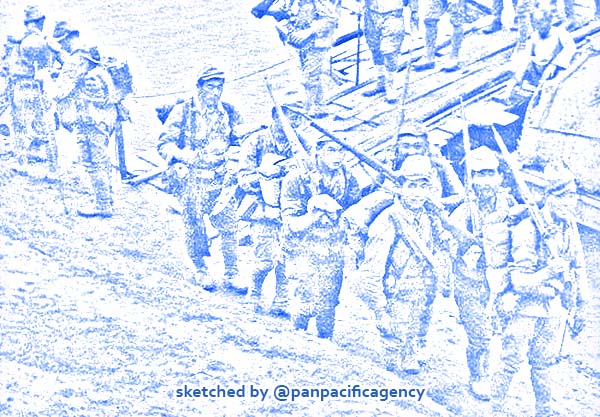Docs allegedly show Imperial Japanese Army’s chemical weapons unit’s escape from China

Heavily-loden Japanese soldiers are pictured while crossing a pontoon bridge in China. They wear M98 field service uniforms and carry bolt-action 6.5mm Ariska rifles. Photo: weapons.com. Sketched by the Pan Pacific Agency.
KYOTO, Feb 10, 2020, The Mainichi. Official documents have been found that appear to detail the escape by purported members of the former Imperial Japanese Army’s chemical weapons research unit from occupied China around the end of World War II, The Mainichi reported.
The documents were introduced on Feb. 8 by Katsuo Nishiyama, a professor emeritus at Shiga University of Medical Science, at a symposium held at Kyoto University in the west Japan city’s Sakyo Ward.
During World War II, Unit 731 is believed to have carried out secret research including human experiments on Chinese prisoners of war, and developed biological weapons and poisonous gases. The official documents Nishiyama presented were originally compiled by the postwar Japanese government, and include information on how the unit pulled out of Manchuria (present-day Northeast China).
Nishiyama said, “Even now new documents are being discovered. If Kyoto University searches too, more may come to light. It’s important for us to continue without giving in.”
Katsuo Nishiyama, professor emeritus at Shiga University of Medical Science, is seen speaking about the documents at Kyoto University, in Sakyo Ward, Kyoto, on Feb. 8, 2020. (Mainichi/Satoshi Fukutomi)
The newly found documents were disclosed to Nishiyama by the National Archives of Japan in November 2019. Among them were files on the Epidemic Prevention and Water Purification Department compiled in September 1950 by the Demobilization Bureau’s Department of Administration for Demobilized Soldiers and Civilian Employees Third Section at the former Ministry of Health and Welfare.
Unit 731 is another name for the Epidemic Prevention and Water Purification Department, which was the germ-warfare unit for the Japanese Kwantung Army which oversaw rule of occupied China. It was sometimes referred to as the Ishii unit, after Shiro Ishii, who studied medicine at Kyoto Imperial University (now Kyoto University) and was the director of Unit 731.
Included was a large map, measuring about 90 by 60 centimeters, which was called the “Kwantung Army Epidemic Prevention and Water Purification Department overview of the course of movements diagram.” It depicts the locations of the unit’s main and supporting branches in the city of Harbin, and an escape route to Japan following the Soviet-Japanese War that took place from August to September 1945.
The Japanese government does not acknowledge that the military engaged in germ warfare. Nishiyama says that following close analysis of the documents, he has challenges ahead. “There are parts written in code that I don’t understand. I want to go further in revealing the truth about the unit,” he said.
(Japanese original by Satoshi Fukutomi, Kyoto Bureau)